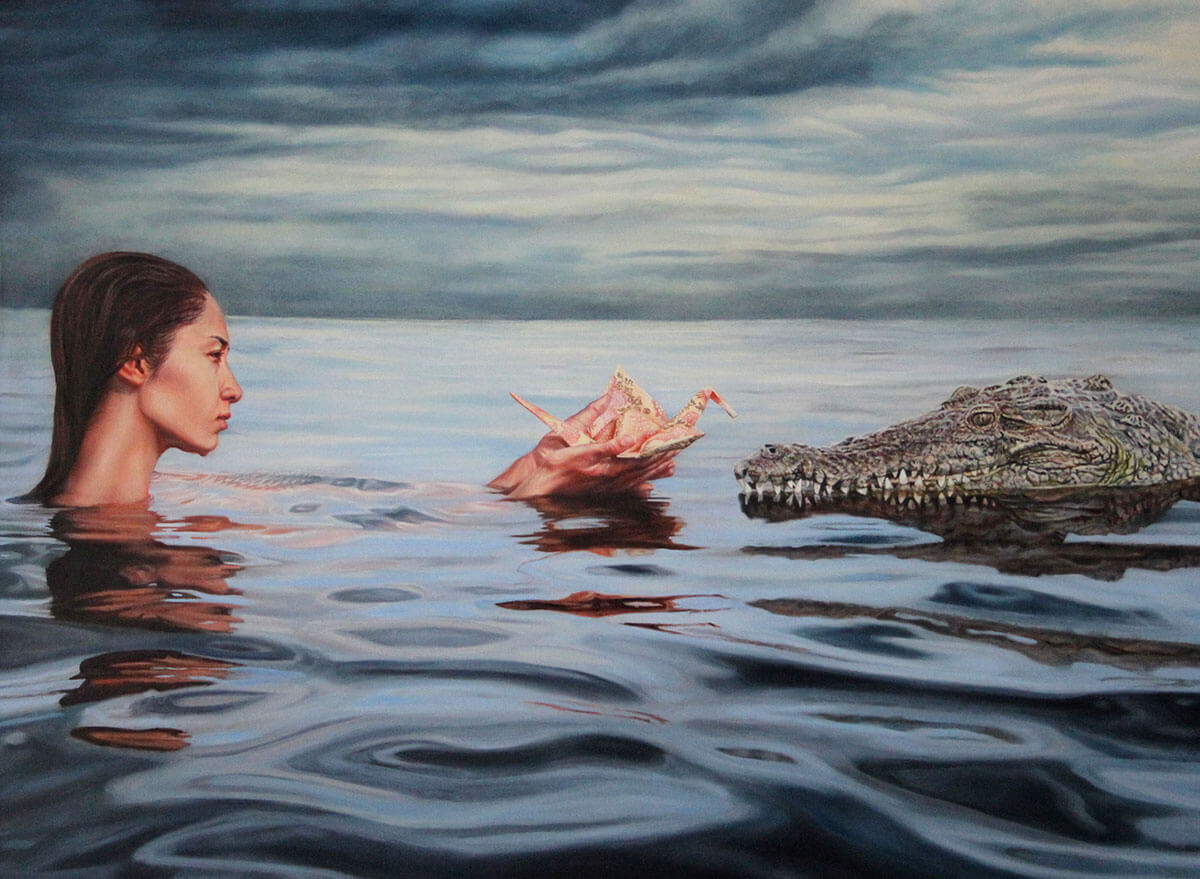Ariel DeAndrea is an oil painter and installation artist who is based out of New York City and Los Angeles. Through Japanese culture, she focuses her efforts on perfecting the artform of the origami paper crane. Traditionally known for its significance within the story of the 1000 paper cranes, these birds come to life within her extremely realistic paintings, and her dynamic installations. Through these art forms DeAndrea demonstrates hope, strength, and dedication encapsulated in these delicate cranes.
Q 1 || Your artist bio says you’re based out of New York City and Los Angeles. Do you think being bicoastal has influenced your artwork at all?
Having the opportunity to work with artists and curators from both coasts has been an amazing experience for me and influences my work in about a million different ways. Not just the dialogue around art, which in my opinion does vary greatly from coast to coast, but the lifestyle, too. I am so grateful to have built friendships and great working relationships with great artists and visionary curators in both places, but the only trouble is, I am always missing one coast or the other, my heart is split between both places at all times.
Q 2 || Your pieces are incredibly intricate. How long does it take you to fully create a painting or installation?
It really depends on the piece, but my work takes anywhere from 100 hours to 1000 hours depending on the piece. The simplest painting takes at least 100 hours, a more complex painting could take 500 plus. The installation takes 500 to 1,000 hours to make depending on the intricacy and about 75 to 100 hours to install. Patience and diligence is the name of the game.
Q 3 || The story of the 1000 paper cranes is very inspirational, and you make it intimate with your installations dedicated to your mother and father. Have you ever been approached by charities or individuals to have a piece commissioned for a specific cause?
There have been many discussions, but nothing concrete yet…I would love to get one into a Children’s Hospital and have attempted in the past. I will keep at it and if anyone out there is reading this and could help facilitate that, it would be a dream.
Q 4 || Water is considered to be one of the most difficult textures to convey in artwork, yet when I first looked at your paintings, I actually thought they were photographs! Did this sort of skill come naturally to you or did you have to hone it to the degree of mastery you possess?
I had very little practice with painting water in particular before it became the central theme in my work and I found that I love painting water. Water reflects all of the world around it, while distorting it into insanely complex form and shape and changing every nanosecond. It is fascinating and beautiful and trying to discern it and make sense of it has been an incredible journey for me. As for my degree of mastery (cover your eyes and ears DaVinci), I have been working my whole life towards better drawing skills and it paid off more than I expected when I took to paint, but I still have a lifetime to learn.
Q 5 || You find a major influence within the Shinto religion for your artwork, since starting have you found yourself experiencing a change in lifestyle due to this degree of interconnectivity?
Folding cranes en masse is in of itself a meditative process that teaches patience and greater inner harmony. Experiencing nature with them takes it to a whole other level for me, looking at the water from down closer to the horizon like a beetle might see it, has been life changing. I do feel the spirit of a place more because I see it through the eyes of this calm little beautiful paper bird that is still and listening, instead of through giant clomping human feet and hungry eyes. I also think painting itself changes a person. I have to be still and alone a lot to be a painter and always looking for the beauty and shape of what it is I am painting. I ask again and again what the essence is of the subject or object, what gives it its spirit, makes it beautiful or ugly or just itself. When I paint, I am working to capture “it” with the gesture of the brush stroke.
Q 6 || A recurring motif within your paintings is the crocodile. What is the significance of this particular animal?
I have reoccurring nightmares about crocodiles. So adept at survival they seem like primordial gods to me in a way. They are an ancient predator, built to survive and kill with ease.
Q 7 || Although you just had a successful show this year with the Thinkspace Gallery, are you already planning any new events or series?
Yes, I have several exciting projects in the works, but I am too superstitious to discuss them just yet.
|| ARIEL DEANDREA
| Official Website | Instagram |

















